Introduction
Sirocco is no wind of change and rushing things is not really the Mediterranean way. It makes perfect sense then that the Nokia 8 Sirocco comes out with last year's chipset and what's now considered an old-school 16:9 aspect display. That's everything old about it though - well, that and, obviously, the name lifted off of one of the special editions Nokia 8800s from the mid-noughties.
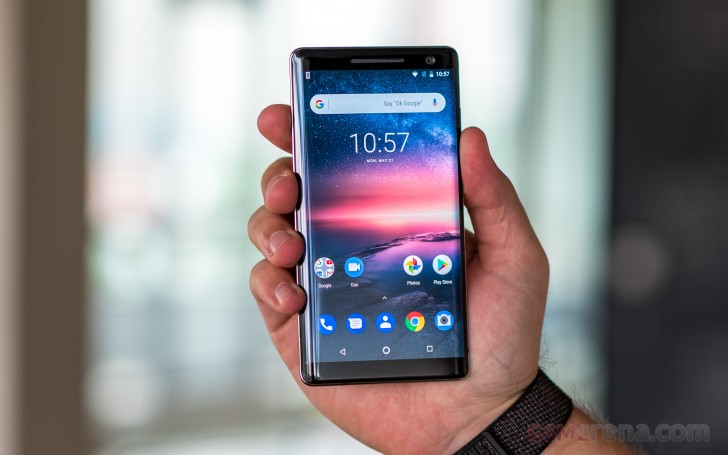
The Nokia 8 Sirocco is more than a little different from the plain 8 that's been out for some 8 months now. A dual-curved 5.5-inch OLED display replaces the 5.3-inch LCD and that comes in an IP67 certified all-glass body, compared to the 8's aluminum backed construction with an IP54 rating.
A new camera setup now includes a large dual pixel primary 12MP sensor in place of the smaller 13MP one on the Nokia 8, and what was a monochrome camera on the 8 is now a telephoto instead. The combo should be mostly the same as the one found on the 7 Plus, but with OIS added in the mix. One could see it as a downgrade that the 8 Sirocco's front camera can't record 2160p videos (the one on the vanilla 8 can), but this 5MP selfie shooter's large pixels promise better low-light images.
A minor bump in battery capacity means the Sirocco comes with a 3,260mAh cell instead of the 8's 3,090mAh, but the extra capacity has eaten up the room for a microSD slot. Or the two are entirely unrelated - either way, the internal storage (an otherwise roomy 128GB) is not expandable.
Nokia 8 Sirocco Specs
- Body: Gorilla Glass 5, stainless steel frame; 140.9x73.0x7.5mm; 177g; IP67 water and dust protection
- Screen: 5.5" pOLED, QHD 2560x1440px resolution, 16:9 aspect, 534ppi
- Rear Camera: Main 12MP, 1.4µm pixel size, f/1.75 aperture lens; Secondary 13MP, 1.0µm pixel size, 2x telephoto f/2.6 aperture lens; dual-tone LED flash, ZEISS optics; 2160p video recording
- Front Camera: 5MP 1.4µm pixel size, f/2.0 aperture, 84-degree FOV, display flash
- Chipset: Qualcomm Snapdragon 835, octa-core CPU (4x2.4 GHz Kryo & 4x1.9 GHz Kryo); Adreno 540 GPU
- Memory: 6GB or RAM, 128GB of storage, no microSD slot
- OS: Android 8.1 Oreo, Android One
- Battery: 3,260mAh, Quick Charge 4.0, 50% in 30 minutes, Qi Wireless Charging
- Connectivity: Optional dual SIM (4G), Bluetooth 5.0, GPS/GLONASS/BDS, Wi-Fi a/b/g/n/ac, NFC, USB Type-C
- Misc: Rear-mounted fingerprint reader, single bottom-firing loudspeaker, Nokia spatial audio with 3 mics
Nope, there's no headphone jack on the Nokia 8 Sirocco - apparently, true flagships can't have one. There's a solution waiting inside the box, so at least there's that.
Nokia 8 Sirocco unboxing
A USB-C to 3.5mm adapter can be found in the bundle in case you want to plug in your own wired headphones. Alternatively, you can use the provided earbuds which connect directly over USB-C.
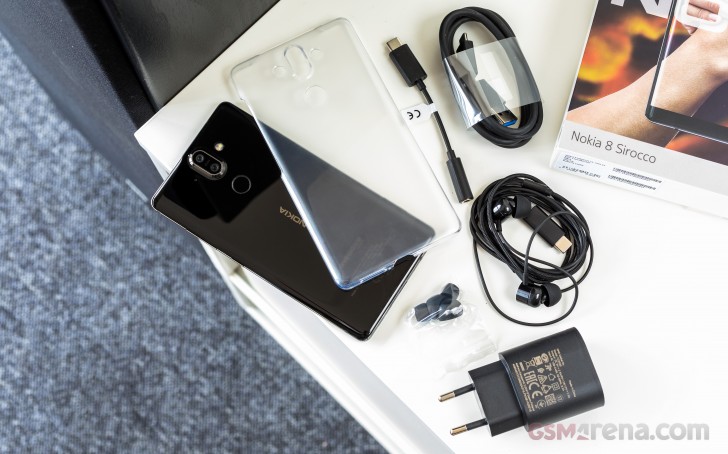
A QuickCharge AC adapter (up to 18W) is included as well as a USB-A to USB-C cable. That's not all though, there's also a semi transparent bumper case made of hard plastic. So hard that we struggled to remove it once it's snapped on, but that's better that it coming off on its own.
You might want to risk it and refrain from using it, and we'd understand - join us on the next page where we admire the Sirocco's looks.
Design and 360-degree spin
Unlike the original 8800 Sirocco which could be had in either black, silver or gold, this new one only comes in black. We've been known for drooling over all sorts of Moroccan blue, Twilight, Flame Red, and whatnot fancy-colored phones, but the Sirocco? The Sirocco's meant to be in black. There's a certain timeless elegance to it.
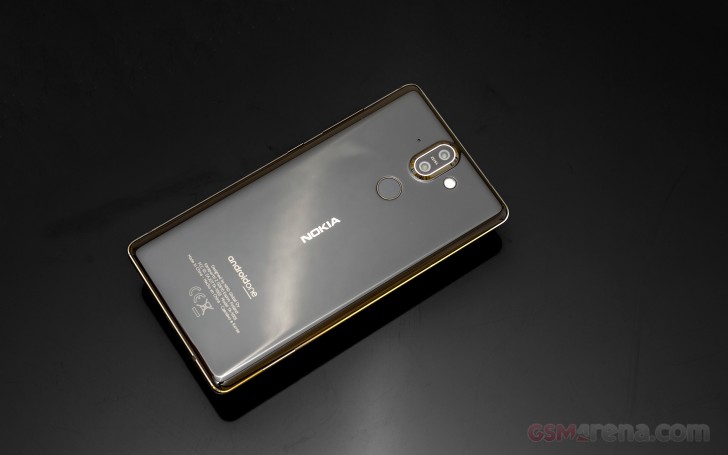
Which is somewhat spoiled by the amount of text on the bottom - the Android One logo we get, but seriously, why does it have to say 'Made in China' in three different languages? Nothing that a tighter framing can't fix.
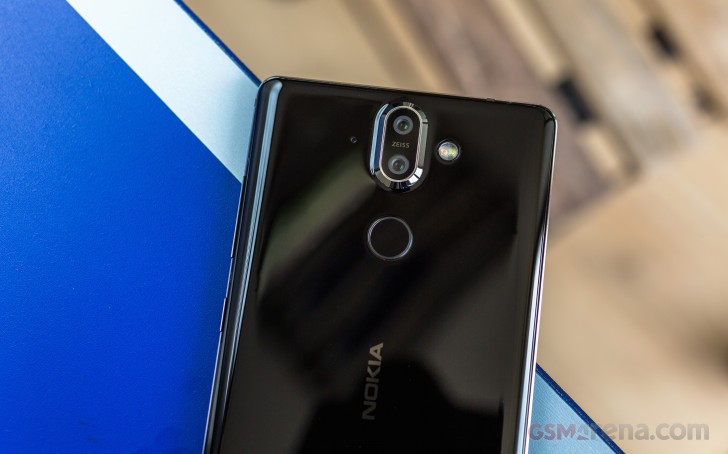
The black slab of Gorilla Glass has a cutout up top for the camera, a dual module setup with a Zeiss badge in between the two lenses - a bit more discreet than the Leica on them Huaweis. The camera bump is noticeably smaller than what Nokia's been doing on its other models and is placed all the way next to the edge - you could say they were going for a more 8800 look.
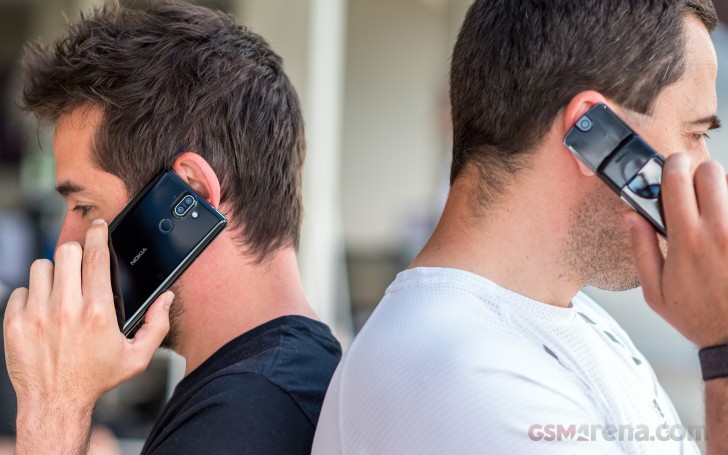
One of three mics the Sirocco has is to the left of the camera, the dual LED flash on the opposite side. A circular fingerprint sensor completes the list of things you'd find on the back.
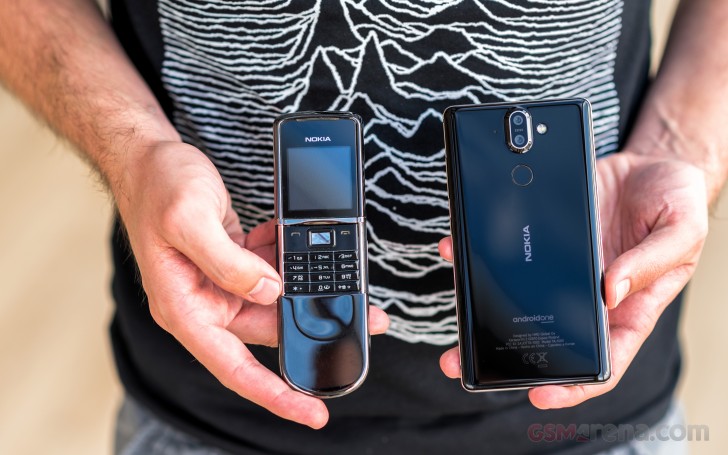
The glass back curves towards the edges, where it meets a stainless steel frame. Most of it is painted black too, except for the chamfers that are left bare. The frame is nicely thin on the sides of the phone which makes the Sirocco feel even slimmer in the hand than the already minimal 7.5mm suggest.
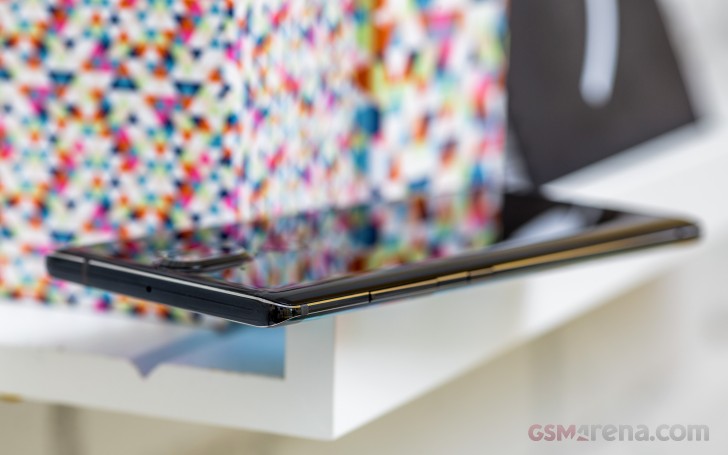
One thing that detracts from the overall premium impression is the buttons - okay, technically three things. Thin and short, they have small travel, and the volume rocker is particularly spongy. Another point for complaints is on the other side - the card tray won't take a microSD for storage expansion. Sure, 128GB is plenty, but more is more.
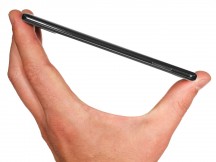
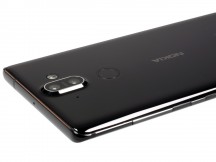

Thin sides • Spot the buttons? • Tray for a lone nano SIM
A pleasant treat awaits on the front - a display in a 16:9 aspect, no rounded corners, no notches or anything - it's like we're transported to a better past. This pOLED panel, however, also reminds us what wasn't better several years ago - we thought the days of strong color shifts at an angle were behind us, but the Sirocco does suffer from that, not unlike the LG V30 and the Pixel 2 XL. Could it be coming from the same LG plant?
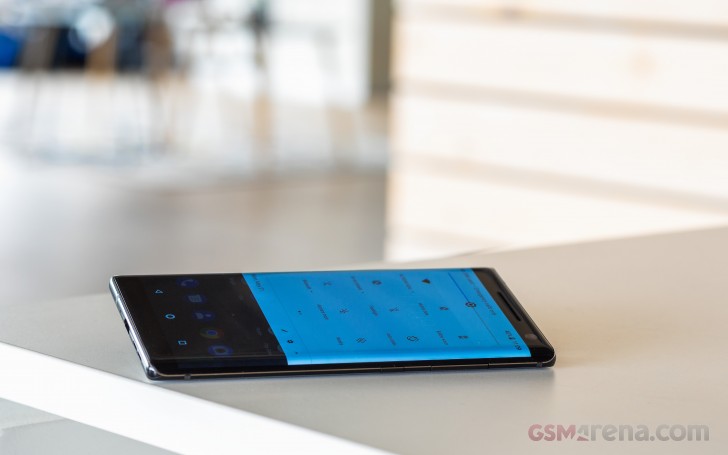
The thing is, on the V30 and the Pixel you could avoid the blue tint by looking at them head-on, and even off-axis it's a uniform shift. Not so on the Nokia, where the display's side edges are curved and so obviously always at a different angle than the rest of the panel. Oh, well.
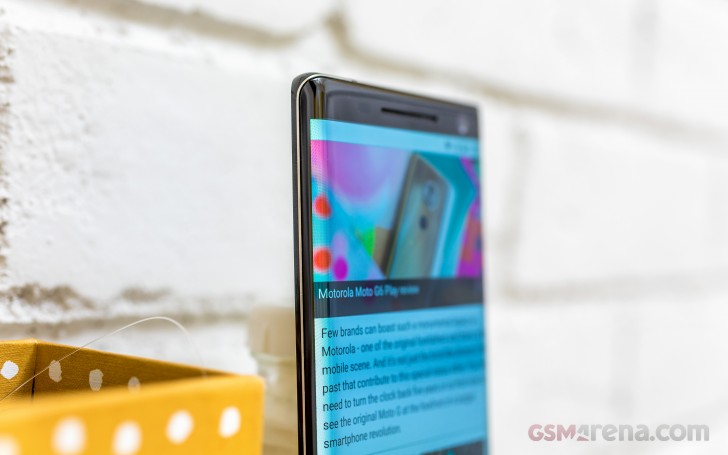
Anyways, above the display is a large earpiece slit, and we can't help but feel like it's a missed opportunity - it's not a second speaker, sadly. The selfie camera is on the right, while the ambient light and proximity sensors are on the other side. Around here is where the status/notification LED should have been if Nokia cared to fit one. Boo.
One more thing Nokia chose not to fit is a headphone jack. On the bottom, you'll find just the USB-C port, the loudspeaker and the primary mic. So, you're telling me there's a chance the 3.5mm jack is up top? Nope, just another mic.



16:9 POLED display • Top bezel with large earpiece • No 3.5mm jack anywhere
The Sirocco measures 140.9 x 73 x 7.5 mm. That's some 7mm shorter than the Galaxy S9 non-plus (which is an almost perfect match in resulting display surface area) and around 11mm less than the LG V30, both of these quite compact as modern flagships go. The Nokia is 4mm wider than the Galaxy, but still narrower than the V30 (which does have more screen to show for its size).
That steel frame may be stainless but it isn't weightless and the Scirocco is relatively heavy at 177g. Couple that with the compact dimensions and the thin sides and you get a particular sense of density about it, one that makes it feel expensive (not that it isn't).
The 5.5-inch pOLED display is not without flaws
The Nokia 8 Sirocco is equipped with a 5.5-inch display with 2,560x1,440px resolution in a classic 16:9 aspect. The math works out to a 534ppi pixel density. The display is also curved to the sides, not unlike recent Galaxies.
It's a pOLED panel, the 'p' in front signifying that it's not made by Samsung more than it does anything else. But you could probably tell anyway - Samsung's dual-curved AMOLEDs haven't exhibited such strong color shifts at the sides like this one does, certainly not lately.

While it is striking at first and can't go unnoticed, particularly on lighter backgrounds, much like the Pixel 2 XL display imperfections it's something that you learn to ignore as you spend time with the phone. It is bad, but it's not as bad as it appears and it's not something you couldn't live with. And, much like with the Pixel 2 XL, the bigger issue here is that you're paying top-dollar but you're not getting your money's worth.
You'd be getting plenty of brightness though, that's for sure. The 400nits the phone achieves in manual mode go all the way up to 600nits if you enable auto brightness. That's quite a similar performance to the V30 by LG, which is perhaps where the Sirocco's display might have been sourced. Unlike the V30, however, the Sirocco's blacks stay truly black in manual mode and the testing hardware only detects a marginal level of illumination in auto. Minimum brightness is also kept nice and low at 3.1 nits.
| Display test | 100% brightness | ||
| Black, cd/m2 | White, cd/m2 | ||
| 0 | 400 | ∞ | |
| 0.002 | 600 | 300000 | |
| 0.382 | 703 | 1840 | |
| 0.254 | 432 | 1701 | |
| 0 | 376 | ∞ | |
| 0 | 631 | ∞ | |
| 0 | 412 | ∞ | |
| 0 | 582 | ∞ | |
| 0 | 420 | ∞ | |
| 0.002 | 414 | 207000 | |
| 0.032 | 616 | 19250 | |
| 0.379 | 387 | 1020 | |
| 0.431 | 618 | 1434 | |
| 0 | 410 | ∞ | |
It's not the greatest out in the sun, the Sirocco, as far as OLEDs go at least. With a 3.745 in our test it's as good as one of the good LCDs. Which is to say, it's perfectly usable outdoors, we're just spoiled by the better OLEDs.
Sunlight contrast ratio
- Apple iPhone X
5.013 - OnePlus 5T
4.789 - Samsung Galaxy S8
4.768 - Samsung Galaxy S8+
4.658 - Samsung Galaxy S9
4.63 - Samsung Galaxy S6 edge+
4.615 - Samsung Galaxy S9+
4.537 - Motorola Moto Z2 Play
4.459 - Oppo R11
4.454 - Samsung Galaxy S7 edge
4.439 - OnePlus 3
4.424 - Samsung Galaxy S7
4.376 - HTC One A9
4.274 - Oppo R15 Pro
4.251 - Samsung Galaxy Note7
4.247 - Samsung Galaxy A3
4.241 - Nokia 8
4.239 - Google Pixel 2 XL (pre-update)
4.234 - OnePlus 3T
4.232 - Google Pixel XL
4.164 - ZTE Axon 7
4.154 - Samsung Galaxy Note8
4.148 - Meizu Pro 7 Plus
4.147 - Samsung Galaxy A7 (2017)
4.124 - Samsung Galaxy S6 edge
4.124 - Huawei Mate 10 Pro (normal)
4.096 - Samsung Galaxy Note5
4.09 - Huawei P20 Pro
4.087 - Nokia 6 (2018)
4.052 - Google Pixel 2 (pre-update)
4.023 - LG V30
4.022 - Huawei Nexus 6P
4.019 - Samsung Galaxy J7 Pro
3.998 - Vivo Xplay5 Elite
3.983 - OnePlus X
3.983 - Oppo R7s
3.964 - Apple iPhone 7
3.964 - Apple iPhone 8 (True Tone)
3.957 - Huawei P9 Plus
3.956 - Meizu Pro 6 Plus
3.935 - Lenovo Moto Z
3.931 - Samsung Galaxy A7 (2016)
3.918 - OnePlus 5
3.914 - Samsung Galaxy C5
3.911 - Samsung Galaxy C7
3.896 - Samsung Galaxy A5
3.895 - Samsung Galaxy J7 outdoor
3.879 - Samsung Galaxy J2 outdoor
3.873 - Motorola Moto G6 Plus
3.865 - Samsung Galaxy A8
3.859 - Samsung Galaxy A8 (2018)
3.842 - Sony Xperia XZs
3.818 - Samsung Galaxy A9 (2016)
3.817 - Motorola Moto X (2014)
3.816 - Samsung Galaxy J7 (2017)
3.812 - Samsung Galaxy A5 (2017)
3.804 - Samsung Galaxy J7 (2016) outdoor mode
3.802 - Xiaomi Redmi Pro
3.798 - LG V20 Max auto
3.798 - Sony Xperia XZ
3.795 - Samsung Galaxy A5 (2016)
3.789 - Apple iPhone 6s
3.783 - Meizu Pro 5
3.781 - Microsoft Lumia 650
3.772 - Xiaomi Mi 6
3.767 - Sony Xperia XZ1
3.765 - Samsung Galaxy J7 (2016)
3.756 - Nokia 8 Sirocco
3.745 - Sony Xperia XZ1 Compact
3.729 - Apple iPhone 8 Plus (True Tone)
3.725 - Oppo F1 Plus
3.709 - Vivo X5Pro
3.706 - Samsung Galaxy A3 (2017)
3.688 - Huawei P20
3.683 - Apple iPhone SE
3.681 - Huawei Mate 9
3.68 - Samsung Galaxy A7
3.679 - Sony Xperia XZ2 Compact
3.675 - Meizu PRO 6
3.659 - BlackBerry Priv
3.645 - Sony Xperia XA1 Ultra
3.597 - Apple iPhone 7 Plus
3.588 - Sony Xperia XZ2
3.58 - LG G6
3.556 - Apple iPhone 6s Plus
3.53 - Motorola Moto Z Play
3.526 - Samsung Galaxy J3 (2016)
3.523 - Samsung Galaxy J3 (2016) outdoor mode
3.523 - Acer Jade Primo
3.521 - Microsoft Lumia 950
3.512 - Oppo R7 Plus
3.499 - Nokia 7 plus
3.479 - nubia Z11
3.466 - Huawei P10 Plus
3.456 - HTC U Ultra
3.453 - Sony Xperia XA2 Ultra
3.445 - Samsung Galaxy J7
3.422 - Motorola Moto G6 Play
3.419 - Meizu MX5
3.416 - LG V20
3.402 - Huawei P10
3.379 - Samsung Galaxy J5 (2016)
3.378 - Oppo R9s
3.352 - Honor 8 Pro
3.341 - Oppo F7
3.333 - Oppo R7
3.32 - Lenovo P2
3.316 - Archos Diamond Omega
3.305 - Honor 9
3.289 - Xiaomi Mi 5s
3.276 - Nokia 5
3.261 - Nokia 6 (Chinese version)
3.244 - Nokia 6 (Global version)
3.238 - Samsung Galaxy J2
3.235 - Sony Xperia X Performance
3.234 - Xiaomi Mi Note 2
3.228 - Motorola Moto X Play
3.222 - Oppo F3 Plus
3.218 - Huawei Mate 9 Pro
3.206 - Huawei P9
3.195 - Xiaomi Mi Mix 2
3.19 - ZTE Nubia Z17
3.159 - Oppo R11s
3.153 - Lenovo Vibe Shot
3.113 - HTC U11 Life
3.108 - Motorola Moto X Force
3.105 - LG Nexus 5X
3.092 - HTC U11
3.089 - Huawei Mate S
3.073 - Microsoft Lumia 640 XL
3.065 - Apple iPhone 6 Plus
3.023 - Asus Zenfone 4 ZE554KL
3.019 - Motorola Moto X4
3.012 - Sony Xperia XA1
3.012 - Sony Xperia L1
2.994 - LG Q6
2.987 - Huawei P10 Lite
2.974 - Samsung Galaxy Note
2.97 - Huawei P20 Lite
2.952 - Xiaomi Redmi 5
2.951 - Huawei Mate 8
2.949 - Sony Xperia XA2
2.938 - Xiaomi Redmi 4
2.92 - Xiaomi Redmi 3S
2.913 - Xiaomi Redmi 5 Plus
2.913 - Sony Xperia XA Ultra
2.906 - LG G5
2.905 - HTC One S
2.901 - Huawei Honor View 10
2.896 - Xiaomi Redmi 3s Prime
2.893 - Xiaomi Mi 5s Plus
2.884 - Sony Xperia XZ Premium (sRGB)
2.877 - Sony Xperia XZ Premium
2.877 - Sony Xperia Z5
2.876 - Nokia 3
2.871 - Microsoft Lumia 550
2.851 - Lenovo Moto M
2.813 - Xiaomi Redmi 3 Pro
2.803 - Sony Xperia Z5 compact
2.784 - Nokia 2
2.752 - Meizu MX6
2.751 - LG V10
2.744 - Huawei Mate 10 (normal)
2.742 - Motorola Moto G5S Plus
2.737 - Xiaomi Redmi 3
2.735 - Huawei Honor 7X
2.734 - Xiaomi Redmi Note 4 (S625)
2.714 - Meizu M5
2.71 - Sony Xperia M5
2.69 - Xiaomi Mi A1
2.689 - Xiaomi Redmi 4 Prime
2.679 - Huawei P9 Lite
2.679 - vivo V7+
2.671 - Vivo V3Max
2.659 - Xiaomi Mi Mix
2.658 - Huawei Mate 10 Lite
2.654 - Oppo F5
2.653 - Doogee Mix
2.642 - Xiaomi Mi 4i
2.641 - Xiaomi Redmi 4a
2.635 - Xiaomi Mi 5X (Standard)
2.616 - Sony Xperia XA
2.609 - Motorola Moto G4 Plus
2.582 - Motorola Moto G4 Plus (max auto)
2.582 - Meizu M5s
2.58 - Xiaomi Mi 4c
2.574 - LeEco Le Max 2
2.567 - Huawei P Smart
2.563 - Asus Zenfone 3 ZE552KL
2.563 - Microsoft Lumia 640
2.563 - Xiaomi Mi Max 2
2.561 - Xiaomi Redmi Note 5A (Y1)
2.556 - HTC U11+
2.556 - Lenovo K6 Note
2.544 - Lenovo Moto G4
2.544 - Oppo F1
2.528 - Sony Xperia Z5 Premium
2.525 - Huawei Honor 7 Lite / Honor 5c
2.506 - Sony Xperia M4 Aqua
2.503 - BlackBerry Motion
2.494 - Oppo F1s
2.481 - Motorola Moto G
2.477 - Lenovo Vibe K5 Plus
2.473 - Huawei G8
2.471 - Huawei nova
2.467 - Lenovo Vibe K5
2.459 - Meizu m3 max
2.447 - Xiaomi Mi 4
2.424 - Xiaomi Mi 5X (Auto)
2.417 - HTC 10 evo
2.407 - Huawei Honor 7
2.406 - Vivo V7
2.404 - Sony Xperia E5
2.386 - ZUK Z1 by Lenovo
2.382 - HTC 10
2.378 - Oppo F3
2.376 - vivo V5 Plus
2.371 - Meizu m1 note
2.362 - Huawei nova plus
2.329 - Razer Phone
2.328 - HTC One E9+
2.305 - Alcatel One Touch Hero
2.272 - Sony Xperia L2
2.266 - Lenovo Vibe K4 Note
2.254 - HTC U11+ (EU)
2.253 - Sony Xperia C5 Ultra
2.253 - Xiaomi Redmi Note 3 (MediaTek)
2.249 - Sony Xperia C4 Dual
2.235 - Xiaomi Mi Note
2.234 - Motorola Moto G (2014)
2.233 - LG Nexus 5
2.228 - Huawei P8
2.196 - Meizu M5 Note
2.189 - Huawei Honor 6
2.169 - Xiaomi Redmi Note 2
2.166 - OnePlus Two
2.165 - HTC One X
2.158 - Xiaomi Redmi Note 4 (X20)
2.145 - LG Aka
2.145 - Archos 50 Diamond
2.134 - Xiaomi Redmi Note
2.119 - Xiaomi Mi 4S
2.095 - Acer Liquid X2
2.084 - Huawei P8lite
2.078 - vivo V5
2.059 - Moto G 3rd gen max manual
2.026 - Xiaomi Mi 3
2.001 - Xiaomi Mi Max
1.996 - Sony Xperia E4g
1.972 - OnePlus One
1.961 - Sony Xperia Z2
1.944 - Meizu m3 note
1.923 - Meizu m2 note
1.892 - BlackBerry Leap
1.892 - HTC Butterfly
1.873 - ZTE Nubia Z9 mini
1.759 - Sony Xperia U
1.758 - Asus Zenfone Selfie
1.68 - Motorola Moto E (2nd Gen)
1.675 - ZTE Nubia Z9
1.659 - Jolla Jolla
1.605 - Motorola Moto E
1.545 - Sony Xperia M
1.473 - Sony Xperia L
1.351 - Xiaomi Redmi 2
1.311 - HTC Desire C
1.3 - Nokia X
1.291 - Meizu MX
1.221 - Sony Xperia E
1.215
The colors are nice and vibrant, but if you're looking for accurate rendition of the sRGB color space, the Sirocco might not be the best choice. It's not terrible, but with an average DeltaE of 6.3 it's just not on par with the best. Whites are off by about 8 units towards blue. There are no color profiles or any options for adjustment either (other than night mode, that is).
Audio quality
The Nokia 8 Sirocco had rather disappointing loudness when hooked to an external amplifier, but its output was generally as good as we've come to expect from smartphones these days.
Plugging in a pair of headphones only harmed the stereo quality, but the increase there was higher than average. The good news was the rest of the readings were barely affected so the overall quality was good. Volume remained rather low though, so you might want to keep away from high impedance headphones with this one.
| Test | Frequency response | Noise level | Dynamic range | THD | IMD + Noise | Stereo crosstalk |
| +0.44, -0.12 | -90.1 | 90.2 | 0.0056 | 0.016 | -88.7 | |
| +0.51, -0.12 | -89.8 | 89.9 | 0.0097 | 0.043 | -39.9 | |
| +0.02, -0.31 | -38.8 | 81.7 | 0.0013 | 4.690 | -95.9 | |
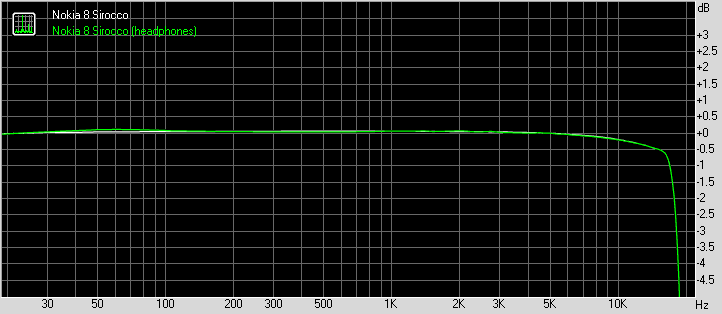
Nokia 8 Sirocco frequency response
You can learn more about the tested parameters and the whole testing process here.
Nokia 8 Sirocco battery life
The number 8 in the Nokia lineup implies a strange battery capacity - the Nokia 8's power pack is rated at 3,090mAh, while this Sirocco we have here now has a 3,260mAh cell. The 6.1 has a classic 3,000mAh capacity, while the 7 Plus packs quite a bit more juice - 3,800mAh.
We ran our usual tests on the Sirocco and the numbers turned out pretty good. We'd have loved to see more than ten hours of web browsing, but the 9:20h we got is okay. Looping videos off the grid, the number goes as high as 12:39h so you should be fine watching shows on transatlantic journeys. We're not ones to talk much, but for those that do, the 21 hours of 3G voice calls from the Nokia should be plenty. In the end, it all adds up to a 77-hour Endurance rating.

Our endurance rating denotes how long a single battery charge will last you if you use the Nokia 8 Sirocco for an hour each of telephony, web browsing, and video playback daily. We've established this usage pattern so our battery results are comparable across devices in the most common day-to-day tasks. The battery testing procedure is described in detail in case you're interested in the nitty-gritties. You can also check out our complete battery test table, where you can see how all of the smartphones we've tested will compare under your own typical use.
When it comes to filling up that battery, the bundled fast charger does a great job. A 30-minute charge got us from flat to 49%, at the hour mark we were looking at 77% and a full charge was achieved in about 1:50h.
Loudspeaker
Continuing a trend of very loud phones, the Nokia 8 Sirocco scored an Excellent mark in our testing. The single loudspeaker's readings were close to those from the Nokia 8 non-Sirocco, and noticeably higher than the Nokia 6.1 in the voice test. While indeed loud, the sound coming out of the Sirocco was rather lacking in the lower register.
| Speakerphone test | Voice, dB | Ringing |
Overall score | |
| 67.8 | 69.5 | 71.5 | Good | |
| 68.4 | 73.2 | 69.9 | Good | |
| 66.2 | 70.4 | 78.2 | Good | |
| 67.5 | 71.3 | 79.7 | Good | |
| 68.1 | 70.1 | 81.5 | Very Good | |
| 69.7 | 73.5 | 76.6 | Very Good | |
| 68.4 | 74.0 | 80.1 | Very Good | |
| 66.9 | 72.3 | 84.5 | Very Good | |
| 67.1 | 74.0 | 85.3 | Very Good | |
| 66.6 | 69.8 | 90.0 | Very Good | |
| 70.1 | 73.8 | 84.2 | Excellent | |
| 83.6 | 76.4 | 80.7 | Excellent | |
| 88.0 | 77.1 | 81.4 | Excellent |
The Sirocco is an Android One phone, and it's at 8.1 Oreo now
The Nokia 8 Sirocco is part of the Android One program, just like the 7 plus. The difference is the Sirocco is a true flagship-grade handset regarding build and looks and so - a viable alternative to a Pixel 2 XL for all those wanting a pure Android alternative to Google's devices. Imagine if it had a newer chipset than said Pixel.
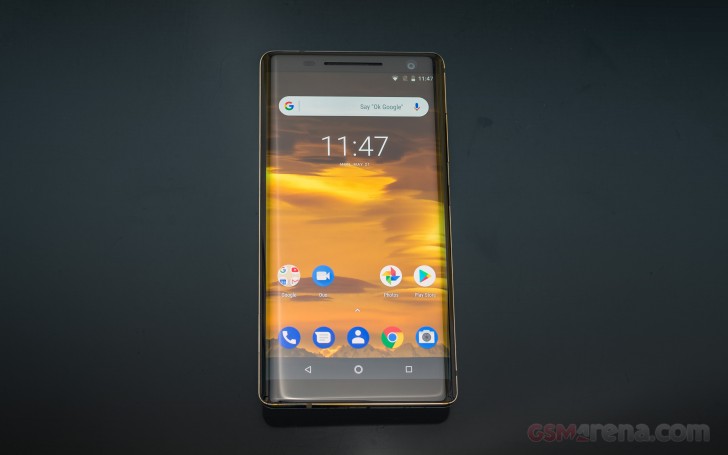
Anyway, Android one means timely updates and the reality so far is proving to live up to the promise - our review unit is running Oreo 8.1 with the most recent May security patch.
Where the Pixel has an Always on display, the Nokia 8 Sirocco has Glance screen. A remnant of Lumia times, its usual behavior is to pop up every time the phone detects movement and to go off after a predefined time-out (up to 30 seconds). It can be configured to show a clock, missed calls count, unread messages count, among other small notifications. On the Sirocco, however, you can leave it on at all times - so you can always glance.
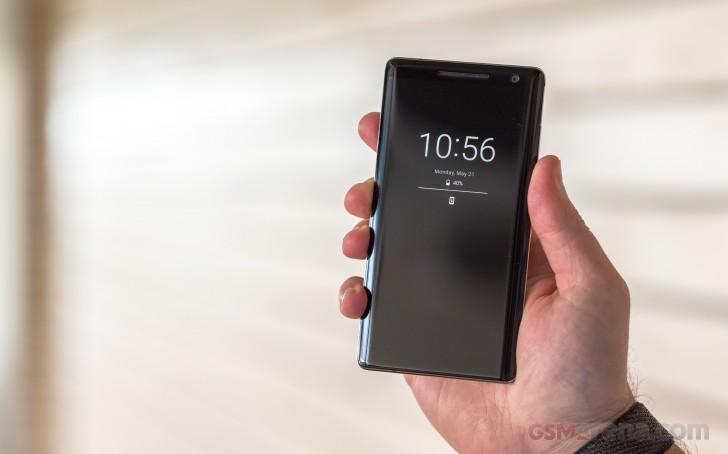
Android as Google intended shows up when you wake up the phone - clock, notification cards, two shortcuts on the bottom. Fingerprint enrollment uses the standard Oreo interface. Unlocking works as advertised and is quick and reliable. Past that is the standard Android 8 homescreen with a pull-up app drawer.





Lockscreen • Ambient display • Fingerprint enrollment • Homescreen • App drawer
The quick toggles and notifications shade changes color depending on the wallpaper - white for lighter ones, black for darker ones. The task switcher is the usual rolodex and wouldn't it be great if Google put the 'clear all' button on the bottom instead of up top? Anyway, multi-window is supported natively since Nougat.
There are several gestures like double press the power button to launch the camera and fingerprint swipe for notifications.
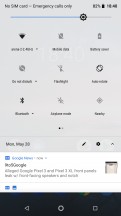


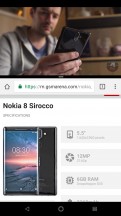

Quick toggles • Notifications • Task switcher • Multi-window • Gestures
As for multimedia, it's all in the hands of Google and its default apps. Google Photos is in charge of gallery-related tasks and video playback, while Google Play Music is the audio player. There's a file manager with batch actions and Google Drive sync, and Google's Calendar is Nokia's calendar of choice.


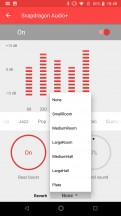
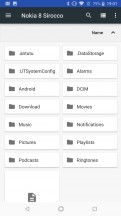

Google Photos • Google Play Music • Equalizer • File manager • Calendar
Synthetic benchmarks
One of the key complaints we have about the Nokia 8 Sirocco is that it comes with last year's chipset. There's nothing wrong with the Snapdragon 835 - it's plenty powerful, but the Sirocco will be fighting with phones packing next-gen silicon. It's in a similar position as the LG G6 was last year when LG went the S820 instead of the S835. The G6 was a bit more affordable than rivals, and all things considered, so is the Sirocco, but you'll know you're getting year-old hardware at almost the same price point as the current generation.

The difference in benchmark performance becomes obvious right away in GeekBench. In the single-core test, the Exynos Galaxy S9+ with its custom cores is all the way ahead, but the Snapdragon 845 devices do post significantly better scores than the S835 Sirocco (curiously, the Snapdragon Galaxy isn't quite as powerful as the Xperia and the Mi Mix 2S).
GeekBench 4.1 (single-core)
Higher is better
- Samsung Galaxy S9+
3771 - Xiaomi Mi MIx 2S
2468 - Sony Xperia XZ2
2454 - Samsung Galaxy S9+ (Snapdragon)
2199 - Samsung Galaxy Note8
1987 - OnePlus 5T
1960 - HTC U11+ (EU)
1952 - Nokia 8 Sirocco
1934 - Nokia 8
1925 - Google Pixel 2 XL
1915 - Huawei Mate 10 Pro
1902 - LG V30
1901 - Huawei P20
1897 - Samsung Galaxy Note8 (SD 835)
1862 - Nokia 7 plus
1634
In multi-core testing, the Exynos 9810 in the Galaxy S9+ doesn't have the same edge, and loses to the Mi Mix 2S, with the other two S45 devices slightly behind. There's a much wider gap between those and the S835 crowd, the Nokia 8 Sirocco included. Its multi-core numbers are similar to other devices with the same chip, as well as the Huawei P20 and Mate 10 Pro, both packing the Kirin 970.
GeekBench 4.1 (multi-core)
Higher is better
- Xiaomi Mi MIx 2S
9158 - Samsung Galaxy S9+
8883 - Sony Xperia XZ2
8466 - Samsung Galaxy S9+ (Snapdragon)
8349 - Samsung Galaxy Note8
6784 - Huawei Mate 10 Pro
6783 - HTC U11+ (EU)
6740 - Nokia 8 Sirocco
6725 - Huawei P20
6722 - OnePlus 5T
6701 - Samsung Galaxy Note8 (SD 835)
6590 - Nokia 8
6568 - Google Pixel 2 XL
6428 - LG V30
6365 - Nokia 7 plus
5893
That same gap in performance between this year's and last year's SoCs continues to be evident in Antutu. If that's any consolation, the Sirocco is one of the higher-scoring S835 devices, along with its non-Sirocco brother. The LG V30, for example, isn't realizing the chip's full potential, the Nokias are.
AnTuTu 7
Higher is better
- Xiaomi Mi MIx 2S
270814 - Samsung Galaxy S9+ (Snapdragon)
264044 - Sony Xperia XZ2
259244 - Samsung Galaxy S9+
246660 - Nokia 8
210323 - Nokia 8 Sirocco
209577 - Huawei P20
206906 - Google Pixel 2 XL
203119 - Samsung Galaxy Note8
201065 - LG V30
182374 - Nokia 7 plus
140820
Not quite so in graphics benchmarks, where the Nokia underperforms, posting fps numbers lower than most in the offscreen tests rendered at 1080p. It gets trickier in the onscreen tests, where the devices' resolution comes into play, but the Sirocco in the QHD team and consecutively framerates suffer.
GFX 3.1 Manhattan (1080p offscreen)
Higher is better
- Samsung Galaxy S9+ (Snapdragon)
61 - Xiaomi Mi MIx 2S
61 - Sony Xperia XZ2
55 - Samsung Galaxy S9+
47 - Samsung Galaxy Note8 (SD 835)
43 - Samsung Galaxy Note8
42 - Google Pixel 2 XL
42 - OnePlus 5T
41 - LG V30
41 - Nokia 8
39 - HTC U11+ (EU)
39 - Huawei Mate 10 Pro
38 - Huawei P20
36 - Nokia 8 Sirocco
34 - Nokia 7 plus
15
GFX 3.1 Manhattan (onscreen)
Higher is better
- Xiaomi Mi MIx 2S
55 - Sony Xperia XZ2
51 - Huawei P20
39 - Huawei Mate 10 Pro
35 - OnePlus 5T
35 - Samsung Galaxy S9+ (Snapdragon)
34 - Samsung Galaxy S9+
24 - Samsung Galaxy Note8
23 - Google Pixel 2 XL
21 - Samsung Galaxy Note8 (SD 835)
20 - HTC U11+ (EU)
20 - LG V30
19 - Nokia 8
18 - Nokia 8 Sirocco
18 - Nokia 7 plus
14
The Nokia 8 Sirocco posted predictable scores in benchmarks, ones you'd expect from a Snapdragon 835 device. That's the thing, though - Snapdragon 845 is the norm in 2018, and it's noticeably more powerful. It's unclear whether you'd be able to appreciate the difference though, and it's mostly a matter of futureproofing - if you're getting last year's hardware today, that's a year less that it'll remain relevant. Additionally, we experienced some overheating after repeated benchmark runs, and with the resulting throttling came lower scores.
12MP normal cam plus 13MP telephoto cam
The Nokia 8 Sirocco has a very compelling camera setup, going by the numbers. The primary cam is built around a 12MP dual pixel sensor (1.4µm pixel size) behind an f/1.75 aperture lens. The secondary cam is a telephoto one that delivers 2x optical zoom, even though Nokia doesn't specify focal lengths (and EXIF data doesn't help too much). It uses a 13MP sensor, this one with 1.µm pixels, though it still outputs 12MP images. It's got a dimmer f/2.6 lens in front. The lenses carry the Carl Zeiss branding - a collaboration that's been going on for years.

As has been the case on recent Nokias, the camera app is practically the only piece of custom software on the Sirocco. If you're easily bothered by the little things, you'd complain about the the position of the rear/front camera switch - it's your only way of going into selfie mode (up/down swipe doesn't work) and it basically requires two hands.
There's a column of icons for quick settings: face smoothing, single/dual/P-I-P (for combined front/rear shots), self timer (off/3s/10s), HDR (off/auto/on), and flash (yup, off/auto/on).
There's a menu button below all these, where you'd find Pro mode. You can also get to it by sliding the shutter release button inward - a neat shortcut since at least the days of the Lumia 1020.
Anyway, Pro mode lets you pick one of five white balance presets, focus manually, choose ISO (100-3200) and shutter speed (1/500s-4s), or set exposure compensation (-2/2EV in full stop increments).
Image quality
The Nokia 7 Plus produced decent photos with what is in all likelihood the same hardware as this Sirocco. However, they are in two different tiers of devices and where the Sirocco stands, the bar is set higher. We'd say the Sirocco misses it, if just barely.
Let's do it a little backwards - the telephoto camera's photos are softer and less detailed than we'd like. The Sirocco's 2x optical zoom will still bring stuff closer and do it better than digital zoom from a wider angle cam, but that's not really a proper yardstick. The latest Galaxy and iPhone telephotos produce noticeably sharper images in good light.






Camera samples, telephoto camera
The main cam's photos are sharper with more definition and superior contrast. Colors are very likable too - vivid but not over the top. What's not so great is dynamic range, and the Sirocco struggles in high-contrast scenes.
Low-light photography isn't the Sirocco's forte, though it still creates usable images. The most obvious issue is the phone's tendency to underexpose dark scenes, so you'll like the results better if you dial in some positive exposure compensation or tap on a dark area to meter for that. Or, if you can be bothered, play with some sliders in post.



Low-light samples - normal camera
As with many dual camera implementations on the market, once the light drops below a certain threshold, the telephoto camera doesn't work and instead you're getting digitally zoomed in shots from the normal cam. You can actually see it in the viewfinder - you tap the zoom button, it goes to tele, and then the composition changes slightly.


Low-light samples - telephoto camera
There are few more convenient ways for side-by-side pixel peeping than our Photo compare tool. We've pitted the Nokia against the Galaxy S9+ and the Huawei P20, but another set of phones is just a couple of clicks away.



Normal camera: Nokia 8 Sirocco against the Galaxy S9+ and the Huawei P20 in our Photo compare tool
The Auto HDR option isn't too trigger happy. In fact, we found ourselves having to force it on in high-contrast scenes, where it probably should have engaged automatically. It's one of those implementations which prioritize highlight detail and bring up the lower midtones, though you might be losing some detail in the deepest shadows. There's a minimal detail penalty when shooting in HDR.






HDR: Off • On • Off • On • Off • On
The Sirocco can shoot quite good panoramas, with plenty of resolution (upwards of 3,000px tall) and fine detail. Stitching is also excellent. Oh, and by the way, unlike on some other phones which limit you to a left-to-right pan, the Sirocco can do panoramas in any direction.
The Nokia 8 Sirocco's Portrait mode is quite proficient at separating subject from background, and the blur looks convincing. However, since the telephoto cam is in charge here, the images are again a little soft, and that's when you do manage to get one in focus, which isn't really all that common.
Selfies
For selfies, the Nokia 8 Sirocco relies on a 5MP cam - it is somewhat low-res, but then it's got large 1.4µm pixels. Wonders are out of the question, but it still does a decent job in challenging light.
In good light, it produces nice selfies with adequate detail (5MP is 5MP) and accurate colors.
There's a faux-bokeh mode for selfies too, naturally, and it also separates subject from background nicely. Remind us again - why are second cameras needed for blurring backgrounds?
Video
The Nokia 8 Sirocco is rather limited in its video recording capabilities. It can do 4K at 30fps (60fps at that resolution isn't a thing with Snapdragon 835 phones) and 1080p at 30fps, but not 1080p at 60fps. Why so, Nokia? Electronic stabilization is not available in 4K, but only in 1080p and you can't turn it off. Why so, Nokia?
2160p videos are recorded with a bitrate of around 42Mbps - just about the standard number for the h.264 codec. 1080p clips get around 20Mbps, which is actually a little more than the average 17Mbps. Audio is recorded in stereo at 256kbps.
You can count on the Sirocco to produce high-quality 4K videos with its main cam - sharp, detailed, and noise-free. Colors are rendered nicely too, perhaps just a little conservatively. 1080p footage is similarly above average in quality, but we feel than the option to turn off the stabilization could have yielded slightly sharper results.
Just like we observed on the Nokia 7 Plus, the telephoto camera's videos have a different white balance making for warmer zoomed in footage. 4K is plenty sharp, 1080p is a bit worse than what you'd get from the main cam.
Again, similarly to the Nokia 7 Plus' behavior, the Sirocco's stabilization has some issues with panning, where it would overshoot a little and take an extra fraction of a second to go back - care should be taken not to pan too fast. Other than that, the stabilization smooths out pretty much everything.
For those of you who want to pixel peep locally, we've uploaded short samples straight out of the phone (2160, 1080p@30 from the normal camera and 2160, 1080p@30 from the telephoto one).
You can also head over to our Video compare tool to see how the Nokia 8 Sirocco renders our test charts. We've pre-selected the Galaxy S9+ and the Huawei P20, but feel free to play around with other phones we've tested.



Nokia 8 Sirocco against the Galaxy S9+ and the Huawei P20 in our Video compare tool
Competition
It's a little retro, the Nokia 8 Sirocco, and it's not just the name that brings back memories of simpler times. A 16:9 aspect display? Who dares do such a thing on a flagship in 2018? And no notch either!

Unfortunately, it's precisely the Sirocco's display that is a bit inadequate for a high-end handset - strong color shifts and blue edges should have been left in the past. It is QHD-sharp, OLED-contrasty, and plenty bright, so it's not bad overall, strictly speaking.
Which is one way to describe the camera. There's no stand-out awesomeness about it, but it will take good photos in most conditions, and the extra reach of the telephoto shooter is appreciated. No stabilization in 4K video, no option to turn of the EIS in 1080p and no 60fps 1080p mode mean you'll be missing options others are offering, though both 4K footage and stabilization in 1080p are actually great.
Speaking of great cameras, the Galaxy S9+ can now be had for Sirocco money, and it would take some serious Finnish brand loyalty not to at least consider it. A vastly more versatile handset, the S9+ has a headphone jack, memory card slot, stereo speakers, better battery life, and superior camera. It's got zero Android One, however, and Samsung's not known for speedy OS updates (though the monthly patches have been coming steadily). Plus, everyone's got a Galaxy, and we haven't seen too many Siroccos out in the wild.
The Huawei P20 Pro seems to be doing better in no small part due to its triple camera, which makes the phone an ideal travel companion (along with some processing magic in low light). Some will prefer the feature-packed custom software of the P20, other will appreciate the no-nonsense Android One on the Nokia - there's no right or wrong answer here. You could also be swayed in the P20 Pro's direction if you're not digging the Sirocco's black paintjob, quite as much as we are - Huawei's color scheme game is on point this year.
Fancy colors is what the LG V30 comes in too, be it S ThinQ or the regular variety. In any case it's the phone to go for if you're after an ultra wide camera (as opposed to the Sirocco's telephoto).
Hot off the presses, the OnePlus 6 will save you a significant amount of cash, while delivering better performance than the Sirocco. Its Optic AMOLED is neither as sharp, nor as bright as the Nokia's POLED, but it's got no pesky color shifts and it's color reproduction is customizable and overall superior. OnePlus has been sticking with a somewhat inexplicable camera setup and the Sirocco's telephoto secondary shooter makes more sense. Again, though - much cheaper, that OP.
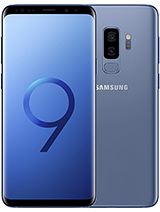
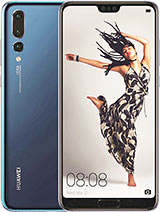
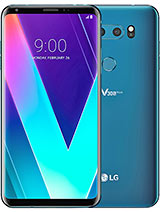
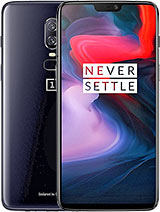
Samsung Galaxy S9+ • Huawei P20 Pro • LG V30S ThinQ • OnePlus 6
Verdict
We've had a tough time with the Nokia 8 Sirocco. We so wanted to love it, and it didn't make it the least bit easy on us. Stupid objective tests yielding just 'good' results instead of the 'amazing' we were counting on.
Pros
- Unique looks, high-quality build (except for the small mushy buttons)
- Dependable battery life, quick top-ups
- Android One means timely updates, and zero bloatware
Cons
- While it is bright when it needs to be, the display's colors are off, there's a blue tint at an angle, and the curved edges are blueish when you're looking at the phone head on
- Photo quality falls a little short of top-tier standards, video is lacking in features
- No microSD slot, no 3.5mm jack, no stereo speakers

Ultimately, it's hard to recommend a flagship with a flawed display and merely okay camera and battery life. This would be the voice of reason. We choose to listen to another voice though, and it insists that going a decade back in time is worth putting up with a few imperfections. Nostalgic types, we are.



























0 Response to "Nokia 8 Sirocco review"
Post a Comment